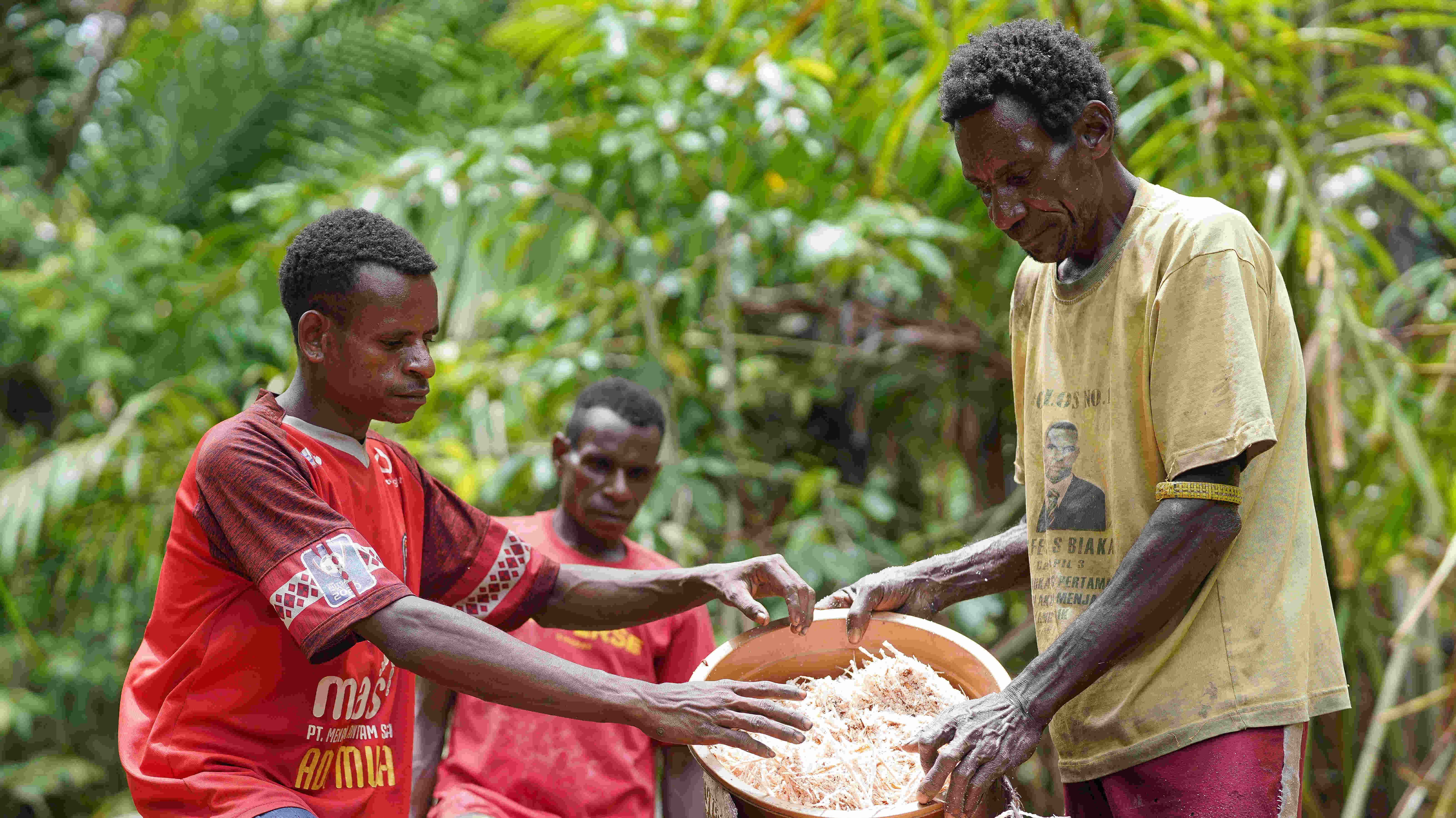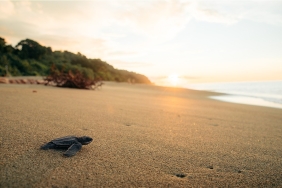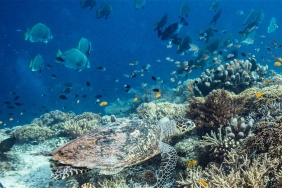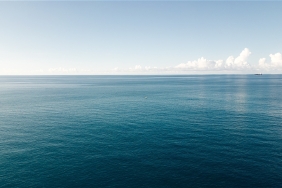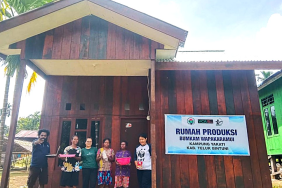WORKING TOGETHER TO SUSTAIN THE HEAVENLY LAND
The wooden floor is neatly arranged, providing a sturdy support for the bridge that connects the villages in the Sawa Erma District, one of the regions in the Asmat Regency, Papua, to the brackish water swamp. Locals refer to it as the Erma Bridge. It took a year to complete the construction of this connecting road, with the workforce consisting of locals who had joined forces for the growth of the village.
The Erma Bridge leads the residents of Sono (pronounced Sona) and Erma villages to reach the district's capital. Before crossing the wooden bridge, residents must first climb a relatively high wooden set of stairs. The distance between each step is quite large, posing potential challenges for unfamiliar visitors.
Beyond the bridge, the residents of Sono village have demonstrated unity. They willingly roll up their sleeves for the sake of the future. The Sono village area is adjacent to Erma. Sawa Erma District itself consists of 10 villages in total other than those two villages, including Agani, Bu, Er, Mumugu, Mumugu Dua, Pupis, Sauti, and Sawa.
Herman Ear, the head of Sono village, is not averse to change. Despite only completing education up to elementary school (SD), Herman continuously hones his skills through informal education. Furthermore, this middle-aged man has held a leadership position since 1999.
Herman often opens the doors of his home wide open to visitors who come to his village. Before reaching his residence, distant guests must walk carefully across the ascending wooden floor. There is a wooden sign marking the village area, with a tin roof above it to protect the writing:
‘ASMAT REGENCY GOVERNMENT
SAWA-ERMA DISTRICT
SONO/JERE VILLAGE’
Herman's house is a bit far from the speedboat mooring area. Herman is delighted to receive visitors, his wife is also pleased with the visit. Herman's appearance is striking. He proudly wears several accessories, including a necklace with dog fangs encircling his neck. Herman also carries a status marker in the form of a noken, hanging in front of his chest.
Herman is a charismatic figure. Although not that tall – perhaps around 168 cm – his stature is upright. His gaze is sharp and firm, evident from his broad facial bones. His jawbone is not as prominent as those of the coastal Papuans.
Herman's wife is leaving her house chores when she greets the visitors. She is a friendly person, resembling the village head's motherly figure, although her sentences may lack structure. Nevertheless, her bright eyes show understanding of the topics discussed.
Receiving visitors from 3,400 kilometers away, Herman asks a neighbor to bring a long bench for us to sit on the terrace of his house. Without hesitation, the young man swiftly takes and lifts it from the Jee (the town hall). Interestingly, the Jee is quite far from Herman's house. The terrace is relatively spacious at that location, at least three times larger than Hendrikus Wowokti or Hengky's terrace, the head of Erma village.
Herman discusses the territory mapping conducted as part of the Voices for Climate Action (VCA) program. With awareness, he states that there has been no negative response from his community. This collaborative effort has been successful thanks to the support of various parties.
Support from the church, indigenous community organizations, and village figures has contributed to the success of the territory mapping effort, a collaboration between WWF-Indonesia and VCA. The church's efforts include socialization through its council. The pastor encourages the community to participate in this program, influencing Herman's perspective that being part of the church community is not only about worship and service but also about working. He has learned that the church also encourages people to connect with nature.
According to the church, the most important foundation for preserving nature is realizing that faith is a working spirit. Nature has a spirit, and so do humans. However, humans have damaged and even destroyed nature.
Herman continues, "Humans and nature has spirits that we can unite, and it becomes a united brotherhood. That's why I've only learned and entered into it. It's better for me to consider it. Consider that nature is one, our friend from the Almighty. Only to avoid what others have done, but let's try not to harm, our nature, so we need to set boundaries."
As someone who has served as the village head for 23 years, Herman is involved in participatory mapping. According to him, the WWF discourse was introduced since the 1990s. Only in the 2000s did participatory mapping take place.
Herman believes that the main issue before mapping was disputes between subvillages due to unclear boundaries. In pursuing mapping, the approach was similar: planting coconut trees, breadfruit trees, bamboo, and guava to establish boundaries. However, Herman added that every boundary plant that fell required his community to replant it, ensuring that the demarcation lines remained clear. This specific planting was located on the outskirts of the bevat (resting place while processing sago or looking for food).
Herman expresses his hopes. He requests that WWF-Indonesia continue its program, understanding that the younger generation tends to be money-oriented. Whereas in the past, they were closely connected and in awe of the environment that provided their food and drink, guiding them back to their families.
According to him, money has no family, nor does it have siblings. Unfortunately, money has spent all the trees. After they turned into money, they were not shared with his family or relatives. Herman shares his thoughts on his concerns about the future. That is why he insists on protecting their forest. Mapping the territory may contribute to alleviating his concerns about the future.
Herman also shares his experience of leaving the Asmat land. Herman's dedication is impressive, as he once requested a budget from the pastor just to attend a palm oil finance training in Kalimantan. He did this to anticipate the invasion of palm oil in his area.
Zaani Inaury, the leader of the VCA program from WWF-Indonesia, explains the reason of choosing Asmat as one of the pilot locations for climate change anticipation efforts. "With the geographical conditions and rapid investment developments, crazy rate of deforestation occurs there, and also the journey of WWF-Indonesia itself in South Papua has a quite long-established presence, and that becomes one of the choices for Asmat. Then, issues like hunger/famine in that year become a reason for the selection of the location," Zaani explains.
In addition to Asmat, VCA also works in the Jayapura area, which is the center of civilization of the island of Papua. "Jayapura is divided into five villages. So, in Asmat, the indigenous community has a cluster system, but actually in one cluster it can be 10-12 villages. For Asmat itself, until today there are 20 villages assisted by the VCA program. So, there are two clusters, each clump has 10 villages," Zaani explained in more detail about the the reason they chose Asmat in this project.
According to Zaani, WWF-Indonesia does not work alone. They collaborate with local civil society organizations (CSOs). "It's called YASA, Alfonso Suada Asmat Foundation. Actually, it is a CSO under the church diocese. Well, in this case, the approach used by WWF-Indonesia and its partners is a church-based approach."
Zaani then adds, "So, how can the community agree and participate in the mapped areas for protection purposes through the church, because in Asmat, the church plays a significant role. That means, besides the government, the community highly values and respects the Church's diocese. The Church is used to facilitate one of the VCA activities, which is this mapping."
In addition to the roles of CSOs and the church, VCA has also encouraged active participation from the regional government, especially the Asmat Regency. "So, after a year of the journey in Asmat, one of the main activities that YASA did related to the VCA program is a series of dialogues built over a year involving important stakeholders related to development in Asmat, one of which is the Asmat Regency Government. Until now, the collaboration built by YASA and the Regional Government has been quite good, so it has helped the smooth running of the VCA program, starting from the Department of Agriculture, the Department of Tourism itself, then the legal bureau. For example, in mapping, YASA collaborates with the Tourism Department, cooperation with the Legal Bureau, and several other agencies, such as the Indigenous Peoples Institution. That's outside the Regional Government," Zaani elaborates.
In addition to mapping traditional territories, VCA also promotes the recognition of intellectual property rights (IPR) owned by the community. "There are already 4 communal IPRs, meaning owned by the community, related to their carvings, boat carvings, and related to some cultural objects, such as spiritual clothes. However, there are also songs. So, individual songs. The IPRs have been obtained. This year, there are plans for two more, namely the traditional houses of Jee and Jeu, and also the Asmat Cultural Festival. The plan is to obtain the IPRs this year," Zaani explains.
Talking about challenges in this powerful collaboration program, Zaani provides further details. "Perhaps Asmat is constrained by access. So, friends and partners are constrained in terms of access. This means unpredictable weather. Even though there are plans, suddenly there could be rough waves, so we have to wait quite a long time to reach the villages. Especially for the filming yesterday, it had to use sea access, such as a speedboat. If the sea is not compromising, so the challenges is about accessibility and unpredictable conditions really."
In the midst of natural challenges, collaboration becomes more effective as the community opens up to change for their future. With the support of various parties, especially the church, villagers organize themselves to face an increasingly vulnerable climate. "As far as the community is concerned, we don't experience too many obstacles because the church plays a considerable role, and they highly respect it. So, whatever is conveyed, especially involving the church, there are actually no obstacles," Zaani concludes the story of this effective collaboration, emphasizing the role of the church and CSOs in this heavenly land.

